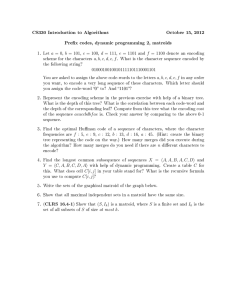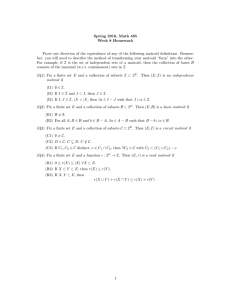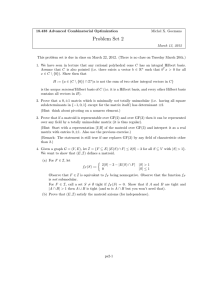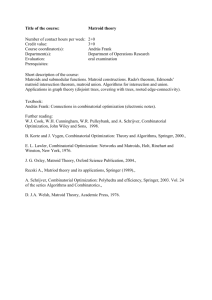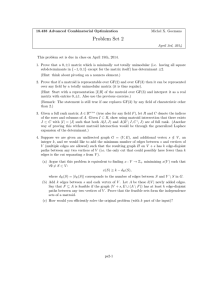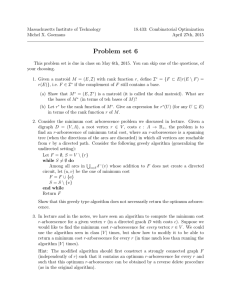Lecture 14
advertisement
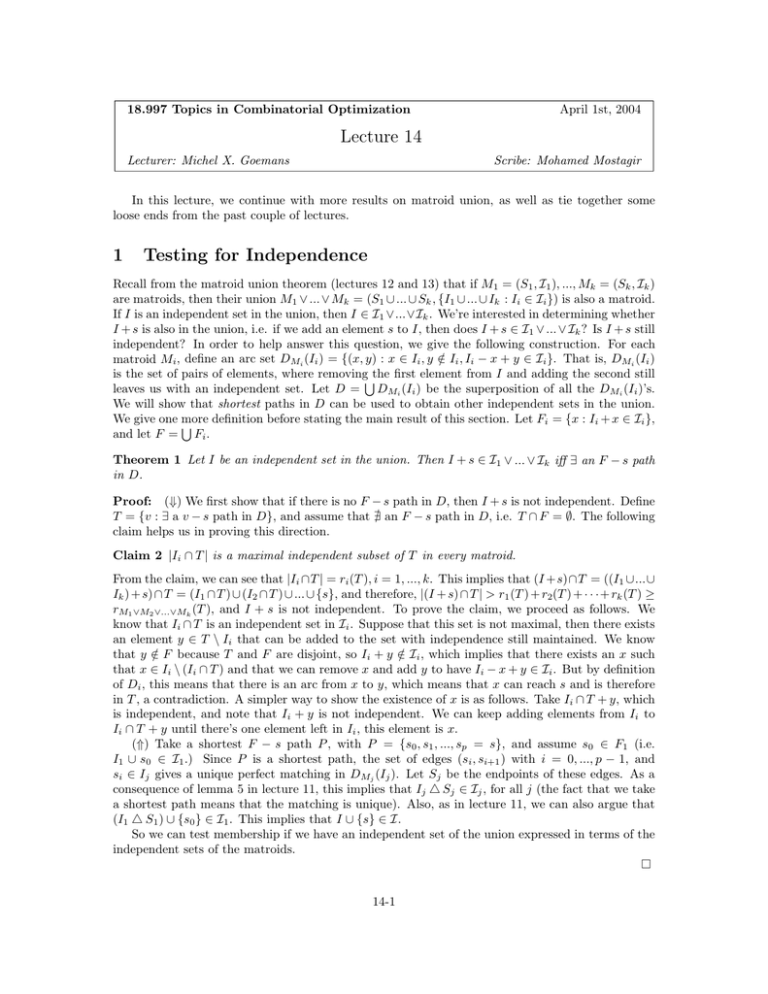
18.997 Topics in Combinatorial Optimization
April 1st, 2004
Lecture 14
Lecturer: Michel X. Goemans
Scribe: Mohamed Mostagir
In this lecture, we continue with more results on matroid union, as well as tie together some
loose ends from the past couple of lectures.
1
Testing for Independence
Recall from the matroid union theorem (lectures 12 and 13) that if M1 = (S1 , I1 ), ..., Mk = (Sk , Ik )
are matroids, then their union M1 ∨ ... ∨ Mk = (S1 ∪ ... ∪ Sk , {I1 ∪ ... ∪ Ik : Ii ∈ Ii }) is also a matroid.
If I is an independent set in the union, then I ∈ I1 ∨...∨Ik . We’re interested in determining whether
I + s is also in the union, i.e. if we add an element s to I, then does I + s ∈ I1 ∨ ... ∨ Ik ? Is I + s still
independent? In order to help answer this question, we give the following construction. For each
/ Ii , Ii − x + y ∈ Ii }. That is, DMi (Ii )
matroid Mi , define an arc set DMi (Ii ) = {(x, y) : x ∈ Ii , y ∈
is the set of pairs of elements, where removingthe first element from I and adding the second still
leaves us with an independent set. Let D = DMi (Ii ) be the superposition of all the DMi (Ii )’s.
We will show that shortest paths in D can be used to obtain other independent sets in the union.
We give one more
definition before stating the main result of this section. Let Fi = {x : Ii + x ∈ Ii },
and let F = Fi .
Theorem 1 Let I be an independent set in the union. Then I + s ∈ I1 ∨ ... ∨ Ik iff ∃ an F − s path
in D.
Proof: (⇓) We first show that if there is no F − s path in D, then I + s is not independent. Define
T = {v : ∃ a v − s path in D}, and assume that an F − s path in D, i.e. T ∩ F = ∅. The following
claim helps us in proving this direction.
Claim 2 |Ii ∩ T | is a maximal independent subset of T in every matroid.
From the claim, we can see that |Ii ∩T | = ri (T ), i = 1, ..., k. This implies that (I + s)∩T = ((I1 ∪...∪
Ik ) + s) ∩ T = (I1 ∩ T ) ∪ (I2 ∩ T ) ∪ ... ∪ {s}, and therefore, |(I + s) ∩ T | > r1 (T ) + r2 (T ) + · · ·+ rk (T ) ≥
rM1 ∨M2 ∨...∨Mk (T ), and I + s is not independent. To prove the claim, we proceed as follows. We
know that Ii ∩ T is an independent set in Ii . Suppose that this set is not maximal, then there exists
an element y ∈ T \ Ii that can be added to the set with independence still maintained. We know
/ Ii , which implies that there exists an x such
that y ∈
/ F because T and F are disjoint, so Ii + y ∈
that x ∈ Ii \ (Ii ∩ T ) and that we can remove x and add y to have Ii − x + y ∈ Ii . But by definition
of Di , this means that there is an arc from x to y, which means that x can reach s and is therefore
in T , a contradiction. A simpler way to show the existence of x is as follows. Take Ii ∩ T + y, which
is independent, and note that Ii + y is not independent. We can keep adding elements from Ii to
Ii ∩ T + y until there’s one element left in Ii , this element is x.
(⇑) Take a shortest F − s path P , with P = {s0 , s1 , ..., sp = s}, and assume s0 ∈ F1 (i.e.
I1 ∪ s0 ∈ I1 .) Since P is a shortest path, the set of edges (si , si+1 ) with i = 0, ..., p − 1, and
si ∈ Ij gives a unique perfect matching in DMj (Ij ). Let Sj be the endpoints of these edges. As a
consequence of lemma 5 in lecture 11, this implies that Ij Sj ∈ Ij , for all j (the fact that we take
a shortest path means that the matching is unique). Also, as in lecture 11, we can also argue that
(I1 S1 ) ∪ {s0 } ∈ I1 . This implies that I ∪ {s} ∈ I.
So we can test membership if we have an independent set of the union expressed in terms of the
independent sets of the matroids.
�
14-1
2
Some applications based on matroid union
For the remainder of this lecture, we will give various results related to matroid union, as well as
some basic properties of the rank function. In the following, M = (S, I) is a matroid with rank
function r; and k ∈ Z+ is a positive integer.
Corollary 3 The maximum size of the union of k independent sets in M is
C = min
U⊆S
[|S \ U | + k · r(U )]
Since S can be covered by k bases iff C = |S|, we derive:
Corollary 4 (Matroid base covering) S can be covered by k bases iff ∀U : k · r(U ) ≥ |U |.
Since there exist k disjoint bases iff C = kr(S), we get:
Corollary 5 (Matroid base packing) There exist k disjoint bases in M iff
∀U : |S \ U | ≥ k(r(S) − r(U ))
Thinking about these corollaries in terms of graphic matroids, we get
Theorem 6 (Nash-Williams) G can be covered by k forests iff ∀T ⊆ V : |E(T )| ≤ k(|T | − 1).
Proof: The only if direction is obvious. To see the other direction, consider any set U ⊆ E.
Assume (V, U ) has l connected components. Let T1 , T2 , · · · , Tl be these l connected components.
By assumption, we have that |E(Ti )| ≤ k(|Ti | − 1). Summing over i, we get that
�
�
|E(Ti )|
k(|Ti | − 1) = kr(U ),
|U | ≤
i
i
�
and thus the claim follows from Corollary 4.
Similarly, we derive:
Theorem 7 (Tutte, Nash-Williams) G contains k edge-disjoint spanning trees iff ∀ partitions ρ
j}.
of V , with ρ = (V1 , ..., Vl ), we have |δ(ρ)| ≥ (l − 1)k, where |δ(ρ)| = {(u, v) : u ∈ Vi , v ∈ Vj , i =
We now turn our attention to some of the properties of the rank function. For a matroid
M = (S, I) with rank function r : 2S → R, we have the following lemma
Lemma 8 The rank function is submodular: ∀A and B ⊆ S, r(A) + r(B) ≥ r(A ∩ B) + r(A ∪ B).
Proof: Let I ⊆ A ∩ B be an inclusion-wise maximal set in I, so r(A ∩ B) = |I|, and let J be such
that I ⊆ J ⊆ A ∪ B and r(A ∪ B) = |J|. Note that both J ∩ A and J ∩ B ∈ I and therefore we have:
r(A) ≥ |J ∩ A|
r(B) ≥ |J ∩ B|
and r(A) + r(B) ≥ |J ∩ A| + |J ∩ B| = |J ∩ (A ∪ B)| + |J ∩ (A ∩ B)| = |J| + |I| = r(A ∩ B) + r(A ∪ B)
�
In fact, the converse also applies, in the sense that if r : 2S → Z+ is such that
i) r(A) ≤ r(B) if A ⊆ B,
ii) r(A) + r(B) ≥ r(A ∩ B) + r(A ∪ B) for all A, B,
14-2
iii) r(A) ≤ |A|.
Then (S, {I : |I| = r(I)}) is a matroid.
As a consequence of submodularity, note that if we have a matroid polytope defined by
x(U ) ≤ r(U )
∀U ⊆ S
xs ≥ 0
∀s ∈ S
or a matroid intersection polytope defined by
x(U ) ≤ r1 (U )
∀U ⊆ S
x(U ) ≤ r2 (U )
∀U ⊆ S
xs ≥ 0
∀s ∈ S.
Then we can solve the separation problem over these polytopes by solving
min[r(U ) − x(U )].
U⊆S
Where x(U ) ≤ r(U ) ∀U , i.e. we can solve the separation problem by minimizing a submodular
function. Cunningham gives a pseudo-polynomial time algorithm to do this. This was later improved to strongly polynomial time by Schrijver and by Fleischer, Fujishige and Iwata. Schrijver’s
algorithm will be covered in a few lectures. Submodular function minimization has many interesting
applications.
We finish this lecture by returning to matroid unions and proving an interesting lemma about the
exchange property for matroid bases (remember that we can switch elements and maintain bases).
Lemma 9 If B1 and B2 are bases of M , and B1 is partitioned into X1 ∪ Y1 , then there exists a
partition of B2 into X2 ∪ Y2 such that X1 ∪ Y2 and X2 ∪ Y1 are bases of M .
Proof: Let’s define two matroids, M1 = M/Y1 and M2 = M/X1 . We want to show that B2 ∈
I1 ∨ I2 . This would mean that B2 can be expressed as X2 ∪ Y2 with X2 ∈ I1 and Y2 ∈ Y2 , i.e.
X2 ∪ Y1 and X1 ∪ Y2 are bases of M . We have from matroid union
rM1 ∨M2 (B2 )
=
=
min |B2 \ U | + rM1 (U ∩ (S \ Y1 )) + rM2 (U ∩ (S \ X1 ))
U⊆B2
min |B2 \ U | + r(U ∪ Y1 ) − r(Y1 ) + r(U ∪ X1 ) − r(X1 )
U⊆B2
≥ |B2 \ U | + r(U ∪ Y1 ∪ X1 ) + r(U ) − |X1 | − |Y1 |
= |B2 | − |U | + |U | = |B2 |
Where the inequality in the second to last equation follows from submodularity. Note that in this
equation, the second term cancels with the two last terms, and r(U ) = |U | (as U is a subset of a
basis) leading to the result.
�
We conclude our discussion by giving the following open problem. Suppose S can be partitioned
into k bases. Is there a way to express S as S = {e0 , e1 , ..., ep−1 } where p = k · r(S) such that for
all i, {ei+1 , ..., ei+r(S) } (where the indices are taken modulo p) is a base?
14-3
